He just wanted to go to the grocery store. But for Gai Riak, who immigrated to the United States from Kenya in 2001, it wasn’t as easy as you’d think. For starters, Riak didn’t have a car. He studied maps and schedules in a foreign tongue and learned the bus system for his first trip. Then, when he arrived — at a store much bigger than anything he was accustomed to — the aisles of packaged items and unrecognizable produce left him overwhelmed and confused. “The food is not the same as the food we get back home,” he says. Labels and price tags meant nothing to him.
Over time, Riak learned the ropes, but without reliable transportation, his trips to the grocery store remained infrequent. “I would buy a lot of nonperishable foods because I never knew when I would have an opportunity to come back,” he says. Rarely did Riak leave with fresh fruits and vegetables.
Grocery shopping challenges like Riak’s impact more than immigrants. Two years ago, Greensboro received a startling distinction: Out of the top 100 major metropolitan cities in the U.S., the Greensboro-High Point area ranked number one for residents experiencing “food hardship.”
Food hardship speaks to a person’s financial ability to buy food, explains Marianne LeGreco, associate professor of communication studies. But hardship, she says, isn’t really the whole story.
Dr. LeGreco mobilizes conversations around food, challenging her students and community partners to look at the problem through a wider lens. To truly address issues of hunger and health, she says, we have to look at “food security,” which puts the focus on physical as well as economic access to food, and on issues such as nutrition and education.
“When we talk about food security, we take a broader look at our food systems,” she says. “That helps us implement true, lasting solutions.”
LeGreco is working to increase food security by uniting organizations with shared goals — from university researchers to community organizations to faith-based groups — who are tackling the problem from different angles.
“We didn’t focus solely on food hardship,” she says of the community’s response to its 2015 ranking. “We mobilized people to start paying attention to food deserts and food insecurity in the community — and more.”
According to the U.S. Department of Agriculture, food insecurity is an economic and social condition of limited or uncertain access to adequate food. Food insecurity includes issues beyond simple hunger, such as levels of food intake and nutrition.
Communication is key
In 2015, LeGreco, alongside faculty from UNCG’s Department of Public Health Education and Department of Interior Architecture, launched the “Local Foodstorm,” a brainstorming event that connected more than 120 community members and students and faculty from UNCG, NC A&T State, Guilford College, Greensboro College, Bennett College, and Guilford Technical Community College. Participants discussed relationships between food and obesity, immigration, race and gender, and economic opportunities. The event is now annual, with hosting responsibilities rotating among campuses.
Ideas gleaned from Local Foodstorm have informed the Guilford County Cooperative Extension’s Local Food Guide and the City of Greensboro’s Fresh Food Access Plan, which makes connections between local food systems and entrepreneurship opportunities.
LeGreco has also partnered with several agencies and community partners, including local farmers, the Guilford County Cooperative Extension, and NC A&T, to establish the Guilford Food Council.
Watering food deserts
As a communication expert, LeGreco understands that the way we talk about food impacts the solutions we put in place.
For example, “there’s a difference between ‘availability of’ and ‘access to’ food,” she explains. In North Carolina, fresh vegetables and many fruits are available year-round. “At the very least, you can grow sweet potatoes. Pound for pound, calorie for calorie, that’s one of the best foods you can eat,” LeGreco says.
But while food may be available in Guilford County, it’s not always accessible — at least not to everybody. Many residents live in “food deserts,” which the U.S. Department of Agriculture defines as areas in which most residents live more than a mile from a grocery store, and below the poverty line.
People living in food deserts can feel stuck there. Like Riak, residents are not in walking distance to a grocery store, and some cannot afford transportation.
“The idea of ‘access’ seems easy to wrap our minds around,” LeGreco says. “And we think we can fix that easily by starting a food pantry, a community garden, or a mobile market. But really, there’s more to it
than that.”
This is where the rhetoric we use when trying to solve problems around food becomes especially important, she adds. Increasing physical access to nourishing foods doesn’t always get at the root of accessibility. “For example, I’ve had several study participants tell me that they would eat better if they knew how to cook. When you’ve grown up in an area where you have access to only convenience foods, you might have never learned to cook,” LeGreco says.
If you give it a try, you run the risk of making a mistake. Suppose you invest in ingredients for a casserole and you drop or burn the casserole while preparing it. “Someone like me might be able to recover from that. I might go out to dinner that night or go buy a replacement ingredient,” she says. “But not everyone has that privilege. Some folks might not eat that night.”
In 2014, LeGreco partnered with the Guilford County Department of Public Health and numerous community partners to launch the Mobile Oasis Farmers Market. This farmers market on wheels provides fresh, local food to people living in food deserts. Even though the market has been a huge success — Guilford College now operates four locations, including one at a local community health clinic, and it won the 2015 Achievement Award in Health from the National Association of Counties — LeGreco points to a key lesson she and her partners learned from data they collected over two years. “Increasing access to healthier food options alone doesn’t guarantee that people are actually going to use them,” she says.
However, they found that increasing access alongside other health resources does encourage participation. “We had much more return business when one of our community members offered recipes and taste tests so that people could know what to do with a butternut squash, or different ways to incorporate ingredients,” LeGreco says. “When we provided those supports, we started to see the creation of community because people would come back.”
LeGreco and her team tracked the participation of 644 Mobile Oasis customers using a web-based app and conducted hundreds of on-site interviews. Forty-three percent of those interviewed said they liked the market because it creates a space to meet people. “Markets are spaces to meet friends, share recipes, and engage in some important social support practices,” says LeGreco.
The takeaway for policymakers? “When we incentivize grocery stores to come into particular neighborhoods, we’re not always capturing the entire problem. We might be doing a lot to create access to resources that people can’t immediately use,” LeGreco says. “It can be far easier to build a store than to fix other problems like a lack of social support or a lack of knowledge or time to cook.”
LeGreco is working to help her community create a strong, sustainable food system that goes a step further than availability and access — to support.
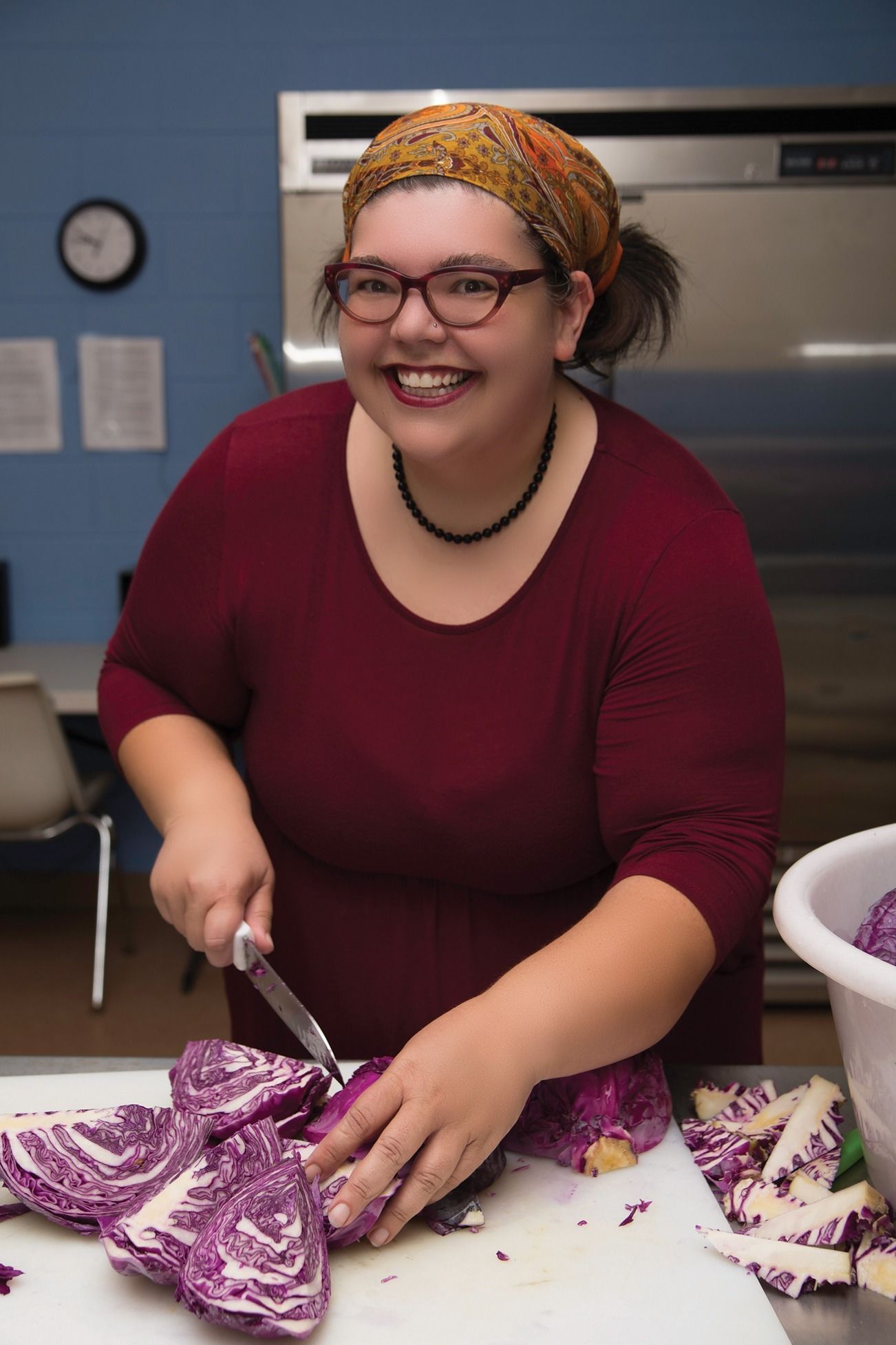
In 2011, LeGreco (above) worked with Guilford County Department of Public Health epidemiologist Mark Smith and a 36-member task force from Greensboro’s Warnersville community, to identify resources to improve the health of community residents. That task force’s work laid the foundation for the Warnersville Urban Garden, which has supplied more than 2,500 pounds of food directly to the community, to local nonprofits such as Share the Harvest and Greensboro Urban Ministry, and to the Mobile Oasis Farmers Market.
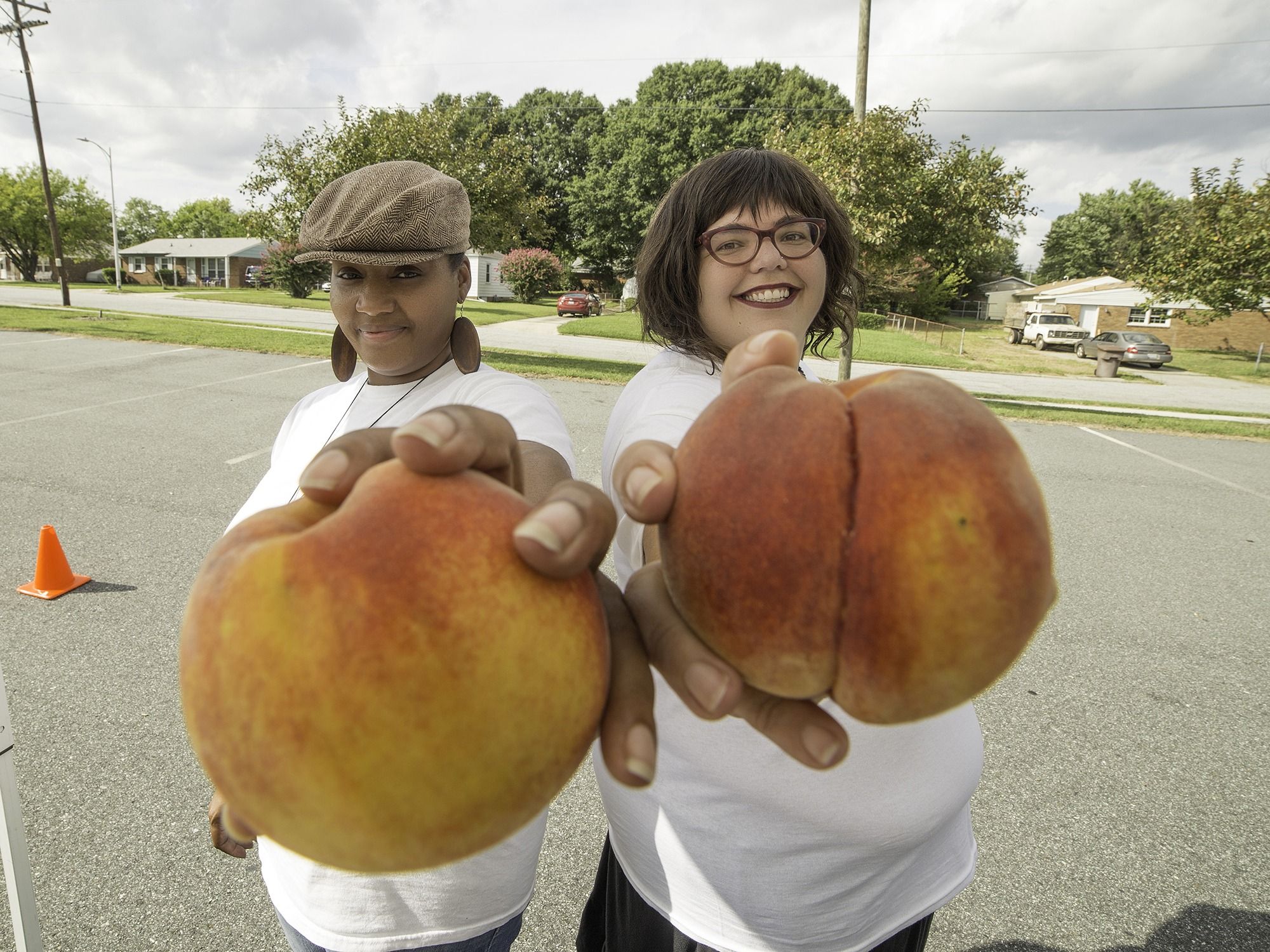
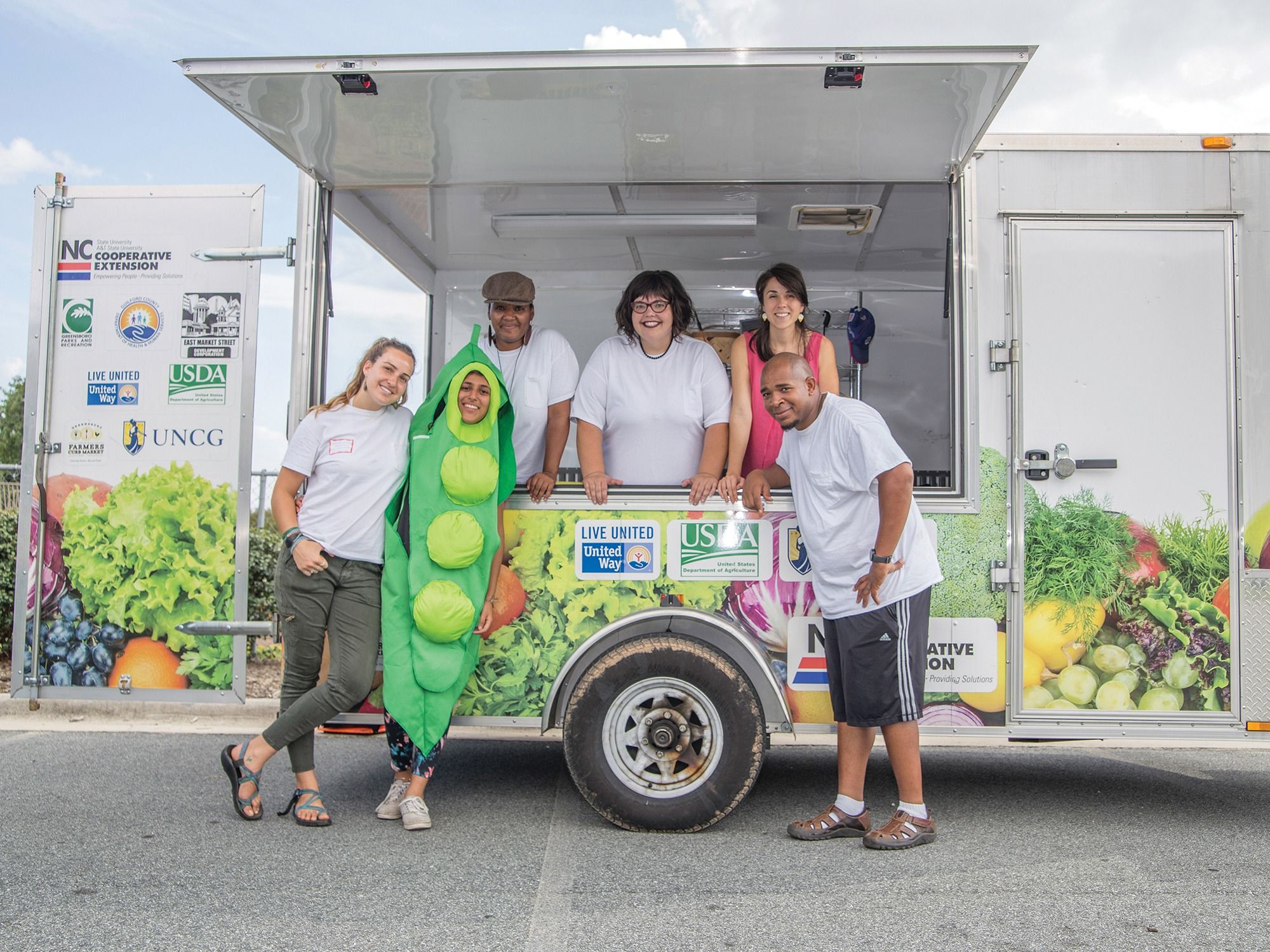

Over the last five years, LeGreco and Dr. Niesha Douglas (left photo, left) have worked together to address local food security issues. Here, they visit the Mobile Oasis Farmers Market with Guilford College colleague Audrey Mangili (center photo, back row, right) and a group of volunteers and students. Over the past 10 years, LeGreco’s students have spent 3,425 hours collaborating with community partners. See more photos on UNCG Research Flickr.
Understanding insecurity
LeGreco is not the only UNCG researcher focused on food issues.
Jigna Dharod, an associate professor of nutrition and a fellow with the UNCG Center for New North Carolinians, works with two seemingly unrelated populations — U.S.-born, low-income women with children, and immigrants and refugees — who both struggle to buy and prepare nourishing food for themselves and their families.
Dr. Dharod has found that rates of food insecurity are far above average in both populations — “even among pregnant women, who are in what is supposed to be a protected stage of life,” she says.
For these groups, Dharod says, food insecurity is associated with a higher intake of sugar-sweetened beverages and meat, and a low intake of nutrient-dense foods such as fruits and vegetables.
That diet walks hand in hand with health issues.
In a recent study of refugees from Bhutan, Somalia, and Sudan, Dharod found extreme rates of chronic diseases like hypertension, diabetes, and high cholesterol.
She pinpointed two causes: First, because of food shortages prior to their journey to the United States, refugees enter their new home with skyrocketing stress levels and a nutritional imbalance. These challenges are only exacerbated by what Dharod calls tremendous access to high-fat, high-sugar foods. “Foods that were previously limited are now cheaper. Here, a bottle of soda is less than a bag of oranges,” she says. “They feel like with limited money, they can buy what was once, in their countries of origin, a luxury item. They aren’t used to comparing nutritional labels.”
Similarly, Dharod has found that food insecurity and obesity coexist among low-income women. “To prevent hunger for themselves and their children, low-income women frequently rely on cheaper food options that are generally high in calories, saturated fat, and sugar,” explains Dharod. “And many are living under high stress, which in turn might increase an appetite for comfort food.”
Despite government support, these difficulties also persist among pregnant women. Dharod recently completed a study on food insecurity and pregnancy outcomes with the Guilford County Department of Public Health’s Women, Infants, and Children (WIC) Program. After interviewing nearly 200 pregnant women on WIC, she found that 51 percent struggled with food insecurity.
The majority of the women interviewed were obese or overweight prior to becoming pregnant, and an even larger majority experienced unhealthy levels of weight gain during their pregnancies. Because weight gain during pregnancy is a significant predictor of both postpartum weight retention and childhood obesity, says Dharod, pregnancy is a crucial time for interventions related to food insecurity. “We have the potential to avert two generations of obesity.”
Dharod’s research findings are making waves at home. Local nonprofits and resettlement agencies have learned the importance of extending their training to include food-related issues. A Guilford College program with ties to UNCG’s Center for New North Carolinians began delivering fruits and vegetables grown on campus to refugee neighborhoods. And NC A&T opened its farm for refugees to harvest vegetables. “These women come from farming backgrounds, so they were thrilled to have the opportunity,” Dharod says.
Dharod’s team also implemented a farmers market at a local WIC office. The project, which won the Catawba County Government Team Award, increased fruit and vegetable consumption among surveyed WIC clients by 50 percent.
Ultimately, she says, her goal is to improve access to nutritious food and prevent poor health. Such interventions will improve health outcomes for multiple generations — and save taxpayers’ money. “We can reduce health care costs through this whole process.”
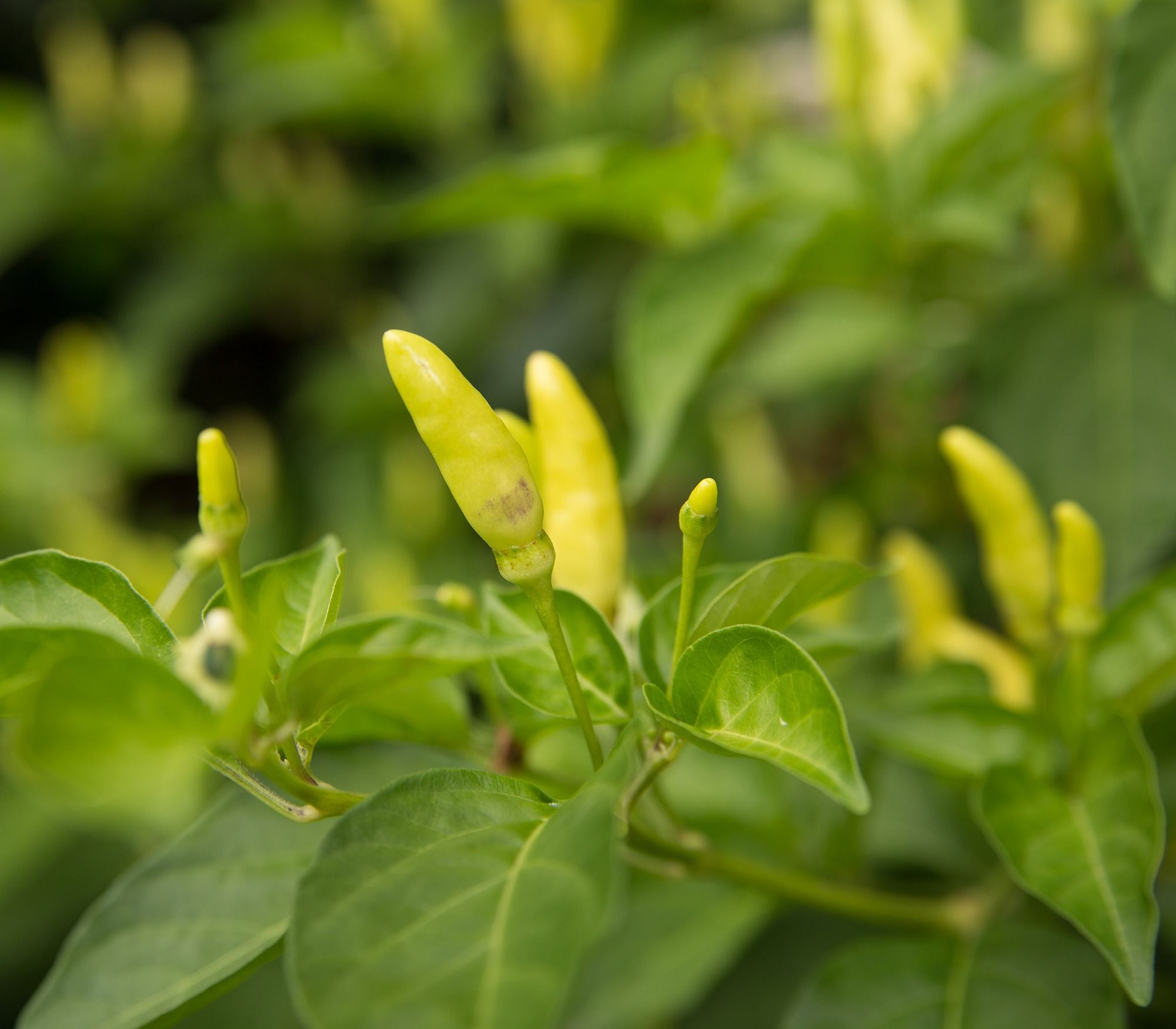
Dharod found that depression during pregnancy is significantly higher among food-insecure women. Currently, she is working with Cone Pediatrics to investigate how food insecurity affects breastfeeding initiation and other infant-feeding practices.
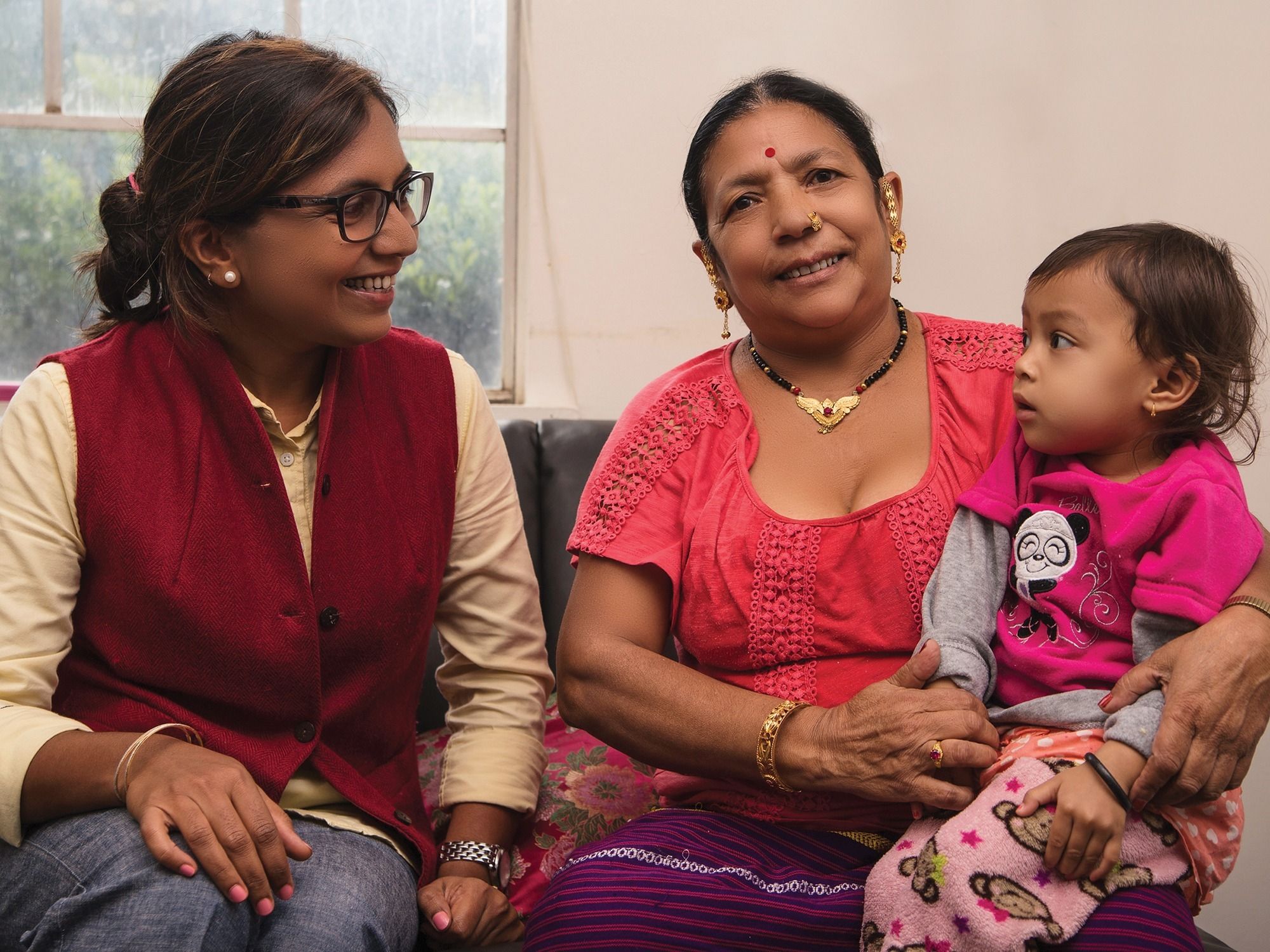
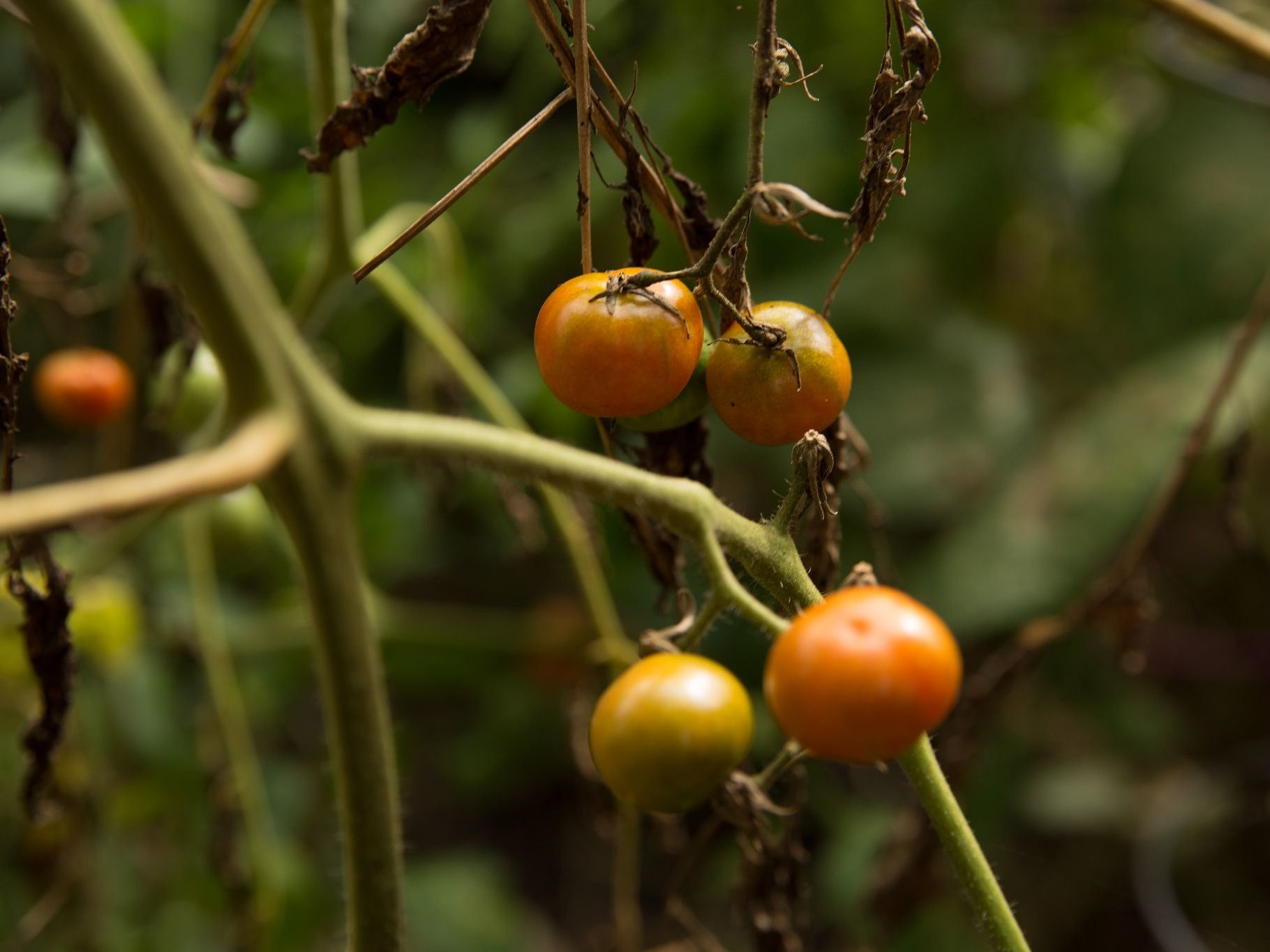
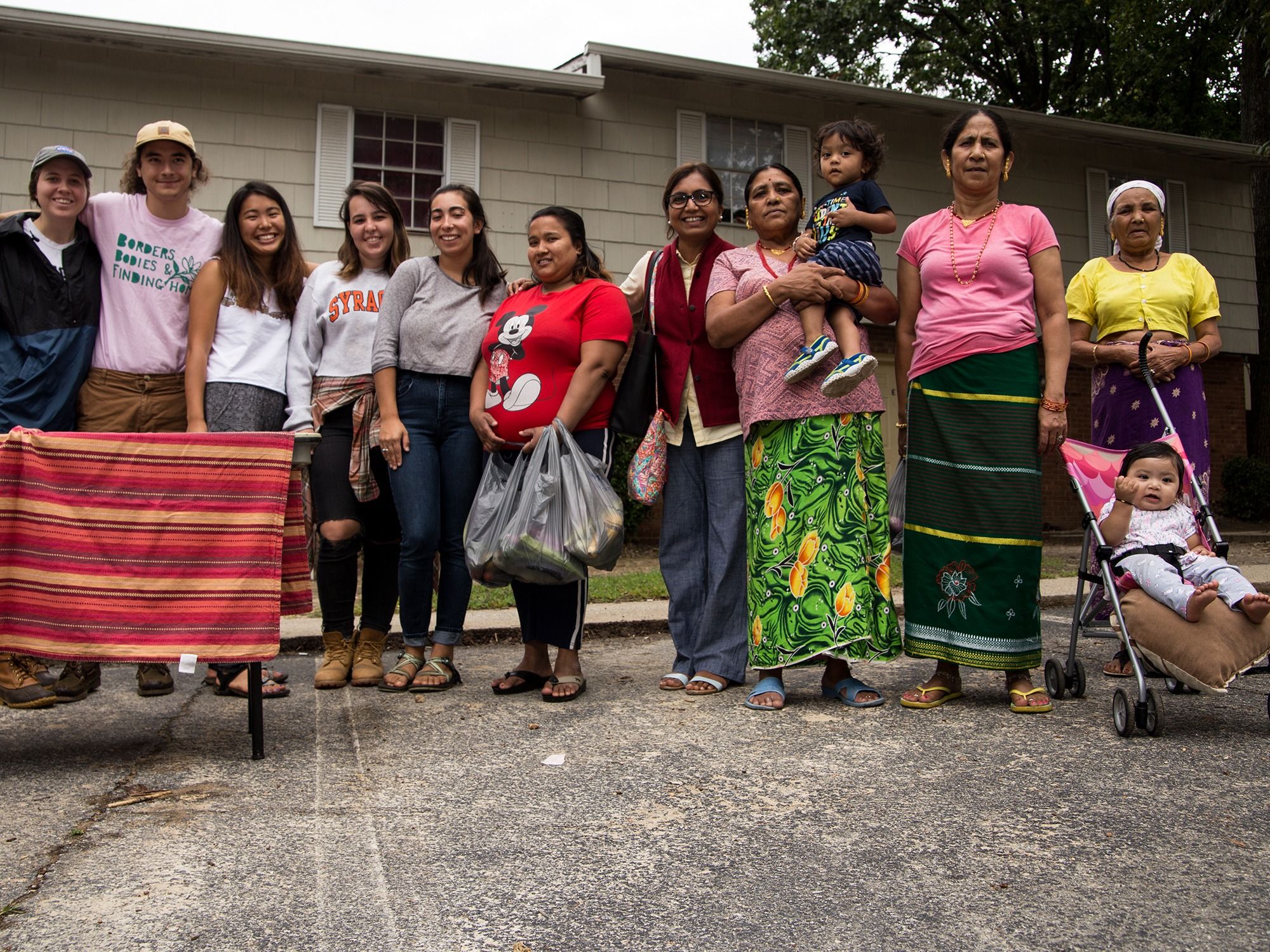
Dharod (left) visits research participants in Greensboro’s Glen Haven community, where families have created a community garden. See more photos on UNCG Research Flickr.
In a study of Liberian refugee and immigrant families, Dharod discovered that refugees experiencing food insecurity actually spent more money on food than their food-secure counterparts. Ability to drive was a major factor — those without a license spent 40 percent more on food.
A university-wide approach
Across departments and disciplines, faculty at UNCG are partnering with community stakeholders to solve challenges around food. These researchers don’t develop solutions for the community. They work with the community to identify problems and design solutions together. Below are just a few of the initiatives that UNCG supports.
Kitchen Connects GSO
Turning a garden full of cucumbers into a grocery store shelf stocked with pickles may seem like a pipe dream for an entrepreneurial gardener, but that’s the kind of idea brought to fruition through the Kitchen Connects GSO program, a collaboration among the Greensboro Farmers Curb Market, the nonprofit Out of the Garden Project, and Guilford County Cooperative Extension. Stephen Sills, an associate professor of sociology who directs UNCG’s Center for Housing and Community Studies, and LeGreco are partnering to collect data about the shared-use kitchen project to track its impact for the project funders, the City of Greensboro and the U.S. Department of Agriculture.
Cottage Grove Build Health Challenge 2.0
Dr. Sills is also working on food security issues with Greensboro’s Cottage Grove neighborhood. With community, agency, nonprofit, and university partners, the neighborhood is combatting widespread health problems such as diabetes and asthma. “Many of these health issues are preventable or treatable with changes in environmental conditions and access to nutritious food, safe places to be active, and healthy housing,” says Sills. The Center for Housing and Community Studies is serving as the independent evaluator and data consultant on the project.
Montagnard Hypertension Research Project
When leaders from Greensboro’s Montagnard refugee community asked area higher education institutions to partner with them to address widespread hypertension and other chronic health conditions, Dr. Sharon Morrison and Dr. Sudha Shreeniwas developed the Montagnard Hypertension Research Project. The associate professors from the Department of Public Health Education and the Department of Human Development and Family Studies are leading an interdisciplinary team that examines a variety of factors contributing to the community’s health, including food insecurity.
Project Green Leaf
Anthropology professor Susan Andreatta developed Project Green Leaf over fifteen years ago as a way to strengthen ties between small-scale farmers and consumers. Over the years, project participants have worked to support the local food system and local agriculture with strategies that include direct marketing and educational and outreach programs. Students also get a chance to get their hands dirty and practice what they’ve learned in UNCG’s Campus Gardens, which Dr. Andreatta co-directs.
Connecting the dots
LeGreco always rests somewhere between big picture and nitty gritty, a trait that gives her perfect reach to all sides. “I am the person who runs around the middle and makes sure everybody is talking to each other,” she says. “I connect ideas to details so they don’t die on the way there — and so we aren’t constantly reinventing the wheel.”
LeGreco is currently organizing a timeline that includes every step taken by researchers and organizations across Guilford County since 2010 to make a stronger food system.
Her timeline includes projects such as Kitchen Connects GSO and the Mobile Oasis Farmers Market, which are only successful if they meet the needs of the citizens they’re designed to serve. To identify immediate impacts, researchers can survey people who use these programs. “But you also have to look at the bigger picture,” LeGreco says. “Sometimes it takes a long time to get from idea to implementation to impact, so we need to look at what else is going on in the food system while these programs are being developed. We need to ask if we are making the right recommendations as we move along.”
To that end, LeGreco is partnering with other UNCG faculty in areas such as kinesiology, nutrition, and sociology — and community stakeholders such as local hospitals and health agencies — to develop common goals and research tools that help communities track and monitor healthy eating, physical activity, and local food systems and determine when projects are successful.
“At the basic level, we as communities need to work to ensure everybody has access to food, water, and shelter,” LeGreco asserts. “Greensboro does a lot of economic development by attracting new people and companies to come here. We talk about our diversity, and how we are a great home to immigrants and refugees.”
But when Greensboro also appears on a list of communities with high food insecurity, it shows that people still struggle. “We have to take care of each other once we are here,” LeGreco says.
“No matter if you were born in the U.S. or not, and no matter your economic and cultural background, we really have to walk the walk when it comes to making sure this is a good place to live and raise our families.”
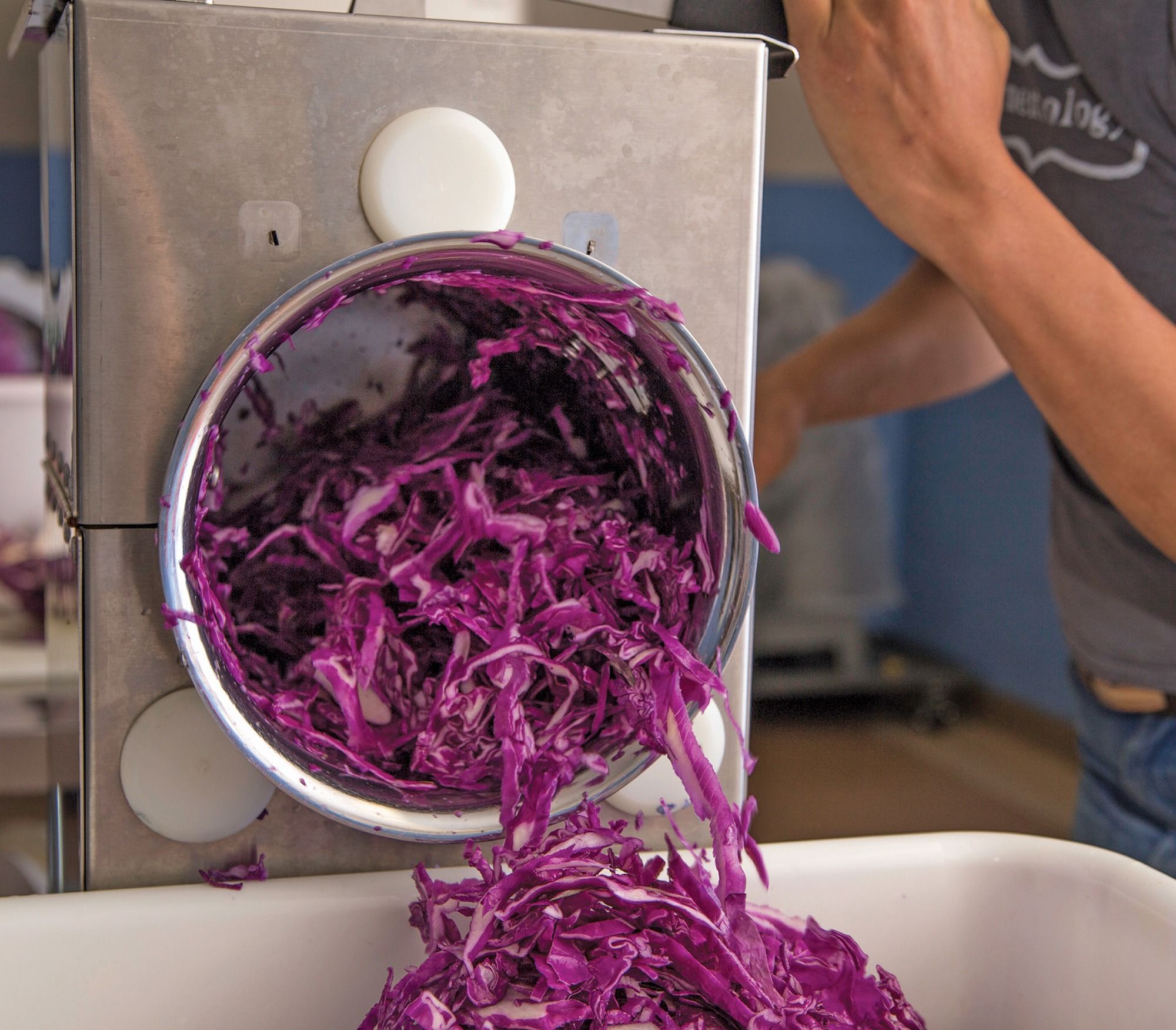
Amy Peddie of Fermentology Foods shreds cabbage in Out of the Garden Project’s shared-use kitchen. Costs and regulations can make it challenging for small business owners to prepare food for sale. Shared-use kitchens help startups like Fermentology Foods take off.